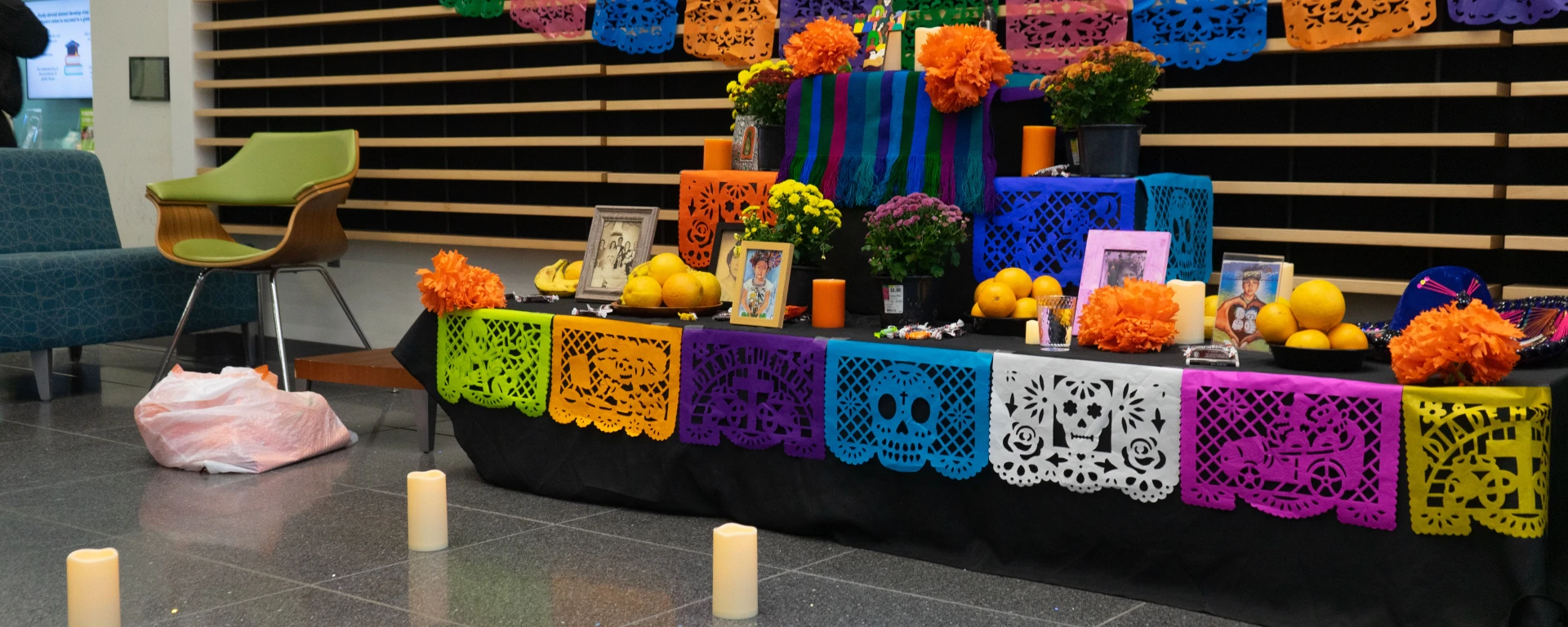First published Nov. 7, 2021 in Stories Beneath the Shell.
by Nathalia Alvarez-Vaca
Orange, purple, green, pink and blue brought Día de los Muertos — the day of the dead — to life in HJ Patterson Hall. Food, drinks, entertainment, an altar and live music were all provided as professors and students gathered to celebrate the event on Tuesday.
A majority of the attendees put pictures or mementos of their loved ones on an ofrenda, or altar, near a wall inside the main study area H.J. Patterson Hall, the University of Maryland’s international center.
“I put a picture of my grandpa on the altar. He passed away last year, not directly due to COVID but it didn’t help his circumstances. So, I am remembering him,” said Gabi Booher, a senior kinesiology major and Spanish minor.

Booher is Salvadorian through her mom. This is her first official time celebrating the event, she said, since she did not get much exposure to Día de los Muertos besides the media. Growing up, her mom would put pictures of her loved ones around the house instead of how the day is typically celebrated in El Salvador, going to the cemetery, placing flowers on the loved ones grave and praying.
The ofrenda was decorated with elements such as bananas and oranges that represent harvest. The elements on the ofrenda are there so “the souls will go and won’t come back,” said Mariana Reyes, a sixth-year PhD candidate studying border immigration.

In front of the ofrenda, four candles placed at a rectangle’s corners surrounded cempasúchil, marigold flowers or “flowers of the dead.” The cempasúchil are used on Día de los Muertos to shelter and keep the souls of the deceased warm, according to Reyes, since the colors of the flower, orange and yellow, represent the sun.
Attendees could drink coffee, hot chocolate or even horchata, a traditional drink from Mexico and Central America. Horchata tastes like milk, cinnamon and vanilla, but the taste varies from where you get it.
They could accompany their drinks with pan de muerto, the bread of the dead. The pan de muerto has parts of the bread sticking out to represent bones. It is only made on Día de los Muertos since it has an intimate significance.
The guests could paint and decorate a ceramic calavera, skull, or take pictures with items like a calavera mask placed on an arts and craft table.
A mariachi group played songs related to Día de los Muertos.

Though Día de los Muertos is celebrated in Latin America as well, event organizer Ana Patricia Rodríguez said this event is different. It acknowledges the people of the Piscataway tribe — whose land Maryland sits on — and the horrors it has experienced. Rodríguez is a Latino and Central American literature associate professor in UMD’s Spanish department
Besides honoring the Piscataway tribe, Rodríguez honored essential workers, people who have died in migration, crossing the border, those who died from COVID-19 and those who died from femicide. The event is to remember all of the women, men, children and our relatives who died, Rodríguez said.
“I am remembering my mother who died when I was 12 and she was 36. She died very young. All my life I really haven’t had a mother. Today, I brought her picture,” Rodríguez said. “Every Día de los Muertos, I have an altar at home for her.”
“[It] doesn’t have to be a person. It can be a pet,” Reyes, the graduate student, said. The event is for “making everything about loved ones.”
Día de los Muertos has a twin holiday, Día de las Muertas: day of the dead but in feminine form, which is celebrated on Nov. 3. It is to remember women who died from femicide.
“I think these types of events are really important for many things because the people of the States who do not know our traditions can learn more about us by these types of events. But I think by holding these events, we are transforming the university,” Reyes said in Spanish.
With these types of events, she said, they are making the university open to everyone — including Latin American cultures.
“We have to fuse those two cultures together, right? So, that’s why I am very happy that we are doing this today.”


Leave a Reply